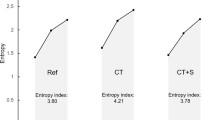Objective. To study the neurophysiological features of cognitive activity in patients with anxiety-depressive and hypochondriasis disorders. Materials and methods. A total of 65 subjects were studied: 16 with hypochondriasis disorder, 23 with mixed anxiety and depressive disorder, and 26 healthy subjects. Heart rate variability and electroencephalography methods were used. Results and conclusions. The EEG showed a decrease in the β1 range after performance of a cognitive task in patients with anxiety-depressive disorder. Patients with hypochondriasis disorder showed a decrease in the duration of the R–R interval and an increase in the frequency of the resting β1 range, an increase in the dominant frequency of β2 activity during performance of the cognitive task, and an increase in the spread of θ frequencies after cognitive tests.
Similar content being viewed by others
References
F. Lederbogen, P. Kirsch, L. Haddad, et al., “City living and urban upbringing affect neural social stress processing in humans,” Nature, 474, No. 7352, 498–501 (2011), https://doi.org/https://doi.org/10.1038/nature10190.
R. Kessler, “The effects of stressful life events on depression,” Ann. Rev. Psychol., 48, No. 1, 191–214 (1997), https://doi.org/https://doi.org/10.1146/annurev.psych.48.1.191.
E. Bromet, L. H. Andrade, I. Hwang, et al., “Cross-national epidemiology of DSM-IV major depressive episode,” BMC Medicine, 9, 90 (2011), https://doi.org/https://doi.org/10.1186/1741-7015-9-90.
V. N. Krasnov, “Diagnosis and classification of mental disorders in Russian psychiatry: affective spectrum disorders,” Sotsial. Klin. Psikhiatr., 20, No. 4, 58–63 (2013).
A. B. Smulevich (ed.), Depression and Comorbid Disorders, Moscow (1997).
W. Rief, A. Hessel, and E. Braehler, “Somatization symptoms and hypochondriacal features in the general population,” Psychosom. Med., 63, 595–602 (2001), http://doi.org/https://doi.org/10.1097/00006842-200107000-00012.
R. Leibbrand, W. Hiller, and M. M. Fichter, “Hypochondriasis and somatization: two distinct aspects of somatoform disorders?” J. Clin. Psychol., 56, No. 1, 63–72 (2000), https://doi.org/10.1002/(SICI) 1097-4679(200001)56:1<63::AID-JCLP6>3.0.CO;2-O.
R. Hirschfield, “The comorbidity of major depression and anxiety disorders,” Prim. Care Compan. J. Clin. Psychiatry, 3, No. 6, 244–254 (2001), https://doi.org/https://doi.org/10.4088/pcc.v03n0609.
D. A. Cousins and H. Grunze, “Interpreting magnetic resonance imaging findings in bipolar disorder,” CNS Neurosci. Ther., 18, No. 3, 201–207 (2012), https://doi.org/https://doi.org/10.1111/j.1755-5949.2011.00280.x.
J. B. Savitz and W. C. Drevets, “Imaging phenotypes of major depressive disorder: genetic correlates,” Neuroscience, 164, No. 1, 300–330 (2009), https://doi.org/https://doi.org/10.1016/j.neuroscience.2009.03.082.
J. B. Savitz and W. C. Drevets, “Neuroreceptor imaging in depression,” Neurobiol. Dis., 52, 49–65 (2013), https://doi.org/https://doi.org/10.1016/j.nbd.2012.06.001.
R. M. Baevskii, G. G. Ivanov, L. V. Chireikin, et al., “Analysis of heart rhythm variability using various electrocardiography systems (methodological guidelines),” Vestn. Aritmol., 24, 65–87 (2001).
B. M. Appelhans and L. J. Luecken, “Heart rate variability as an index of regulated emotional responding,” Rev. Gen. Psychol., 10, 229–240 (2006), http://doi.org/https://doi.org/10.1037/1089-2680.10.3.229.
P. M. Baevskii, O. I. Kirillov, and S. E. Kletskin, Mathematical Analysis of Changes in Cardiac Rhythm in Stress, Nauka, Moscow (1984).
G. Valenza, P. Allegrini, A. Lanatà, and E. P. Scilingo, “Dominant Lyapunov exponent and approximate entropy in heart rate variability during emotional visual elicitation,” Front. Neuroeng., 5, 3 (2012), https://doi.org/https://doi.org/10.3389/fneng.2012.00003.
J. Keller, J. B. Nitschke, T. Bhargava, et al., “Neuropsychological differentiation of depression and anxiety,” J. Abnorm. Psychol., 109, No. 1, 3–10 (2000), http://doi.org/https://doi.org/10.1037/0021-843X.109.1.3.
R. I. Machinskaya, “Executive systems of the brain,” Zh. Vyssh. Nerv. Deyat., 65, No. 1, 33–60 (2015), https://doi.org/https://doi.org/10.7868/S0044467715010086.
G. E. Bruder, C. E. Tenke, V. Warner, et al., “Electroencephalographic measures of regional hemispheric activity in offspring at risk for depressive disorders,” Biol. Psychiatry, 57, No. 4, 328–335 (2005), https://doi.org/https://doi.org/10.1016/j.biopsych.2004.11.015.
I. R. Il’yuchenok, A. N. Savost’yanov, and R. G. Valeev, “Dynamics of the spectral characteristics of the θ and α EEG ranges in negative emotional reactions,” Zh. Vyssh. Nerv. Deyat., 51, No. 5, 563–571 (2001).
V. B. Strelets, N. N. Danilova, and I. V. Kornilova, “EEG rhythms and psychological indicators of emotions in reactive depression,” Zh. Vyssh. Nerv. Deyat., 47, No. 1, 11–21 (1997).
T. S. Mel’nikova, and I. A. Lapin, “EEG coherence analysis in depressive disorders of different origins,” Sotsial. Klin. Psikhiatr., 18, No. 3, 27–32 (2008).
J. Bailer, M. Witthöft, M. Erkic, and D. Mier, “Emotion dysregulation in hypochondriasis and depression,” Clin. Psychol. Psychother., 24, No. 6, 1254–1262 (2017), https://doi.org/https://doi.org/10.1002/cpp.2089.
A. H. Kemp, K. Griffiths, K. L. Felmingham, et al., “Disorder specificity despite comorbidity: resting EEG alpha asymmetry in major depressive disorder and post-traumatic stress disorder,” Biol. Psychiatry, 85, No. 2, 350–354 (2010), https://doi.org/https://doi.org/10.1016/j.biopsycho.2010.08.001.
B. Saletu, P. Anderer, and G. M. Saletu-Zyhlarz, “EEG topography and tomography (LORETA) in diagnosis and pharmacotherapy of depression,” Clin. EEG Neurosci., 41, No. 4, 203–210 (2010), https://doi.org/https://doi.org/10.1177/155005941004100407.
G. E. Bruder, R. Fong, C. E. Tenke, et al., “Regional brain asymmetries in major depression with or without an anxiety disorder: a quantitative electroencephalographic study,” Biol. Psychiatry, 41, No. 9, 939–948 (1997), https://doi.org/https://doi.org/10.1016/S0006-3223(96)00260-0.
L. B. Ivanov, N. N. Strekalina, N. Yu. Chulkova, and A. B. V. Budkevich, “Variants of the spatial distribution of α activity depending on the type of affective disorder,” Funkts. Diagn., 1, 41–50 (2009).
J. B. Allen, H. L. Urry, S. K. Hitt, and J. A. Coan, “The stability of resting frontal electroencephalographic asymmetry in depression,” Psychophysiology, 41, 269–280 (2004), https://doi.org/https://doi.org/10.1111/j.1469-8986.2003.00149.x.
L. A. Bokeriya, O. L. Bokeriya, and I. V. Volkovskaya, “Cardiac rhythm variability: measurement methods, interpretation, and clinical utilization,” Annaly Aritmol., 4, 21–32 (2009)
Author information
Authors and Affiliations
Corresponding author
Additional information
Translated from Zhurnal Nevrologii i Psikhiatrii imeni S. S. Korsakova, Vol. 119, No. 3, Iss. 1, pp. 43–49, March, 2019.
Rights and permissions
About this article
Cite this article
Lebedeva, N.N., Maltsev, V.Y., Pochigaeva, K.I. et al. Neurophysiological Features of Cognitive Activity in Patients with Anxiety-Depressive and Hypochondriasis Disorders. Neurosci Behav Physi 50, 137–142 (2020). https://doi.org/10.1007/s11055-019-00879-w
Received:
Published:
Issue Date:
DOI: https://doi.org/10.1007/s11055-019-00879-w




